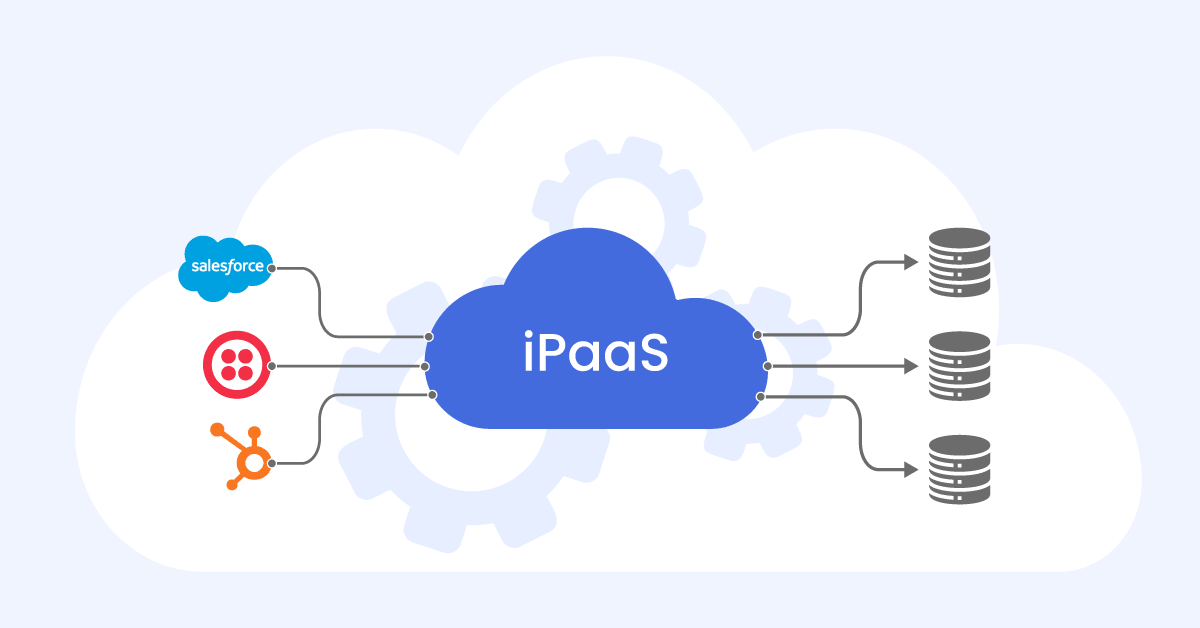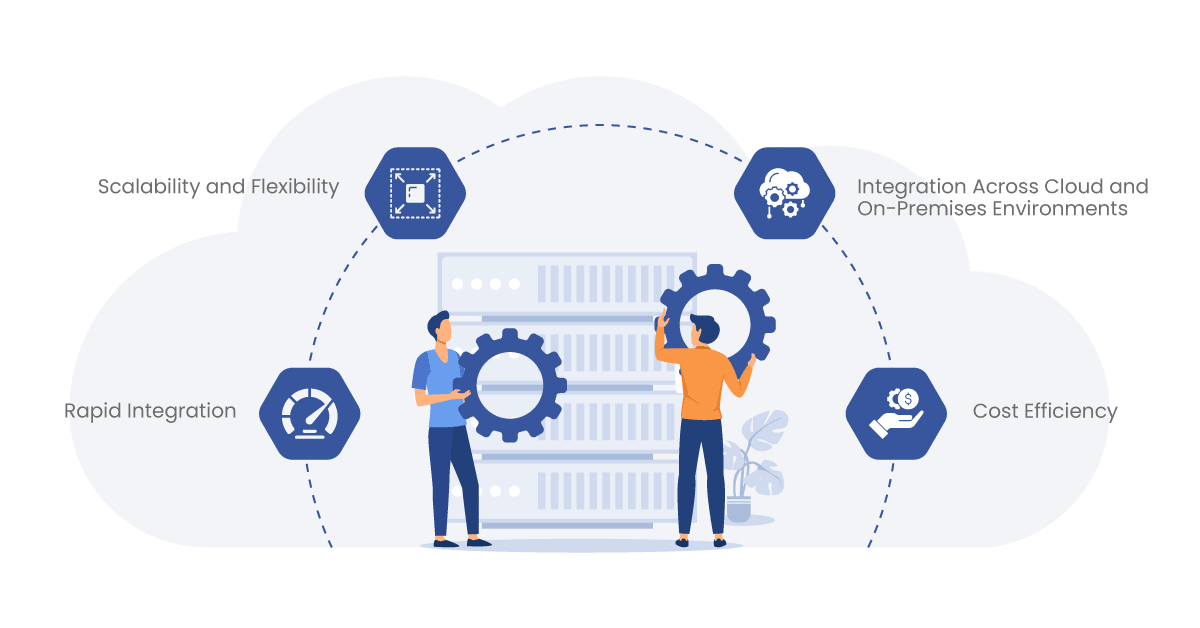In today’s digital landscape, businesses generate vast amounts of data from various sources, such as customer interactions, sales transactions, and operational processes. To unlock the full potential of this data, organizations need to implement robust data integration strategies. Integration Platform as a Service (iPaaS) solution has emerged as a powerful tool that enables seamless data connectivity, simplifying and accelerating the integration process.
In this article, we will explore the key components of a strong data integration strategy and how iPaaS solutions can help organizations achieve their integration goals.
Aonflow iPaaS – Free for First 3 Months!
Build and run up to 1,500 transactions monthly with no cost. No payment info needed!
The Importance of Data Integration
Harnessing the Power of Data: Data integration plays a crucial role in aggregating, transforming, and consolidating data from disparate sources, enabling businesses to derive meaningful insights and make informed decisions. According to a study by McKinsey, organizations that effectively leverage data integration see a 12% increase in profit margins. For example, a retail company can integrate data from their point-of-sale systems, e-commerce platforms, and customer relationship management (CRM) systems to gain a comprehensive view of customer behavior, enabling them to personalize marketing efforts and drive sales.
Enhancing Operational Efficiency: By streamlining data flow between applications, systems, and databases, data integration reduces manual data entry, minimizes errors, and improves overall operational efficiency. For instance, a manufacturing company can integrate its production systems with inventory management and supply chain systems, automating data exchange and reducing the time spent on manual data reconciliation.
Key Components of a Strong Data Integration Strategy
Define Integration Objectives: Before implementing any data integration solution, it is essential to clearly define integration objectives and determine the data sources, systems, and applications involved. This ensures alignment with business goals and facilitates a targeted approach to integration. For instance, a healthcare organization may aim to integrate electronic health records (EHRs), medical imaging systems, and billing systems to achieve a unified view of patient data and streamline medical workflows.
Choose the Right iPaaS Solution: Selecting the appropriate iPaaS solution is critical for successful data integration. Consider factors such as scalability, security, ease of use, and compatibility with existing systems. Gartner’s Magic Quadrant for Enterprise iPaaS can provide valuable insights and guidance. For example, a financial services company looking to integrate its customer relationship management (CRM) system with its accounting software may choose an iPaaS solution that offers pre-built connectors for both systems, ensuring smooth data flow and reducing integration complexity.
Data Mapping and Transformation: Data mapping involves aligning data elements from different sources to ensure consistency and accuracy. iPaaS solutions offer powerful mapping and transformation capabilities, allowing organizations to manipulate and enrich data as it flows through the integration pipeline. For instance, a global e-commerce company can use data mapping to reconcile product codes, descriptions, and pricing across multiple systems and languages, ensuring consistent product information for customers worldwide.
Data Quality and Governance: Maintaining data quality is paramount in any integration strategy. iPaaS solutions often include data cleansing and validation functionalities that help identify and rectify inconsistencies, duplicates, and errors. Implementing robust data governance practices ensures data integrity and compliance with regulations. For example, a telecommunications company can implement data quality checks during the integration of customer billing systems, reducing errors and billing disputes.
Real-time Data Integration: In today’s fast-paced business environment, real-time data integration has become a necessity. iPaaS solutions enable near-instantaneous data synchronization, facilitating timely decision-making and improving operational agility. A prime example from IBM case studies is PayPal, which implemented real-time data integration to reduce fraud and improve customer experience. By continuously syncing transaction data from various payment channels, PayPal can quickly identify and prevent fraudulent activities, enhancing security and trust for their customers.
Aonflow is the leading integration platform.
You can kick-start by integrating your first-ever workflow in just a matter of minutes.
Benefits of iPaaS Solutions in Data Integration
Rapid Integration: Traditional integration methods often require significant time and effort. iPaaS solutions provide pre-built connectors and templates that expedite integration processes, enabling organizations to achieve faster time-to-market and gain a competitive edge. For example, a software-as-a-service (SaaS) startup can leverage iPaaS to integrate its platform with popular cloud storage providers, allowing users to seamlessly access and share files without delays.
Cost Efficiency: iPaaS solutions eliminate the need for extensive coding and custom development, reducing the cost and complexity associated with data integration projects. According to a survey by Forrester, organizations using iPaaS solutions experienced a 3-year ROI of 410%. Organizations can allocate resources to other critical business areas by avoiding expensive development efforts. For instance, a manufacturing company can redirect its IT budget towards improving production processes rather than investing in custom integration solutions.
Scalability and Flexibility: As businesses grow, so do their data integration requirements. iPaaS solutions offer scalability and flexibility, allowing organizations to seamlessly handle increasing data volumes and accommodate new applications or systems without disrupting existing integrations. This scalability is essential in industries with seasonal demand fluctuations, such as retail and hospitality. For example, a hotel chain can easily onboard new properties into its centralized reservation system using iPaaS, ensuring smooth integration and data synchronization across all locations.
Integration Across Cloud and On-Premises Environments: Many organizations operate in hybrid environments, utilizing both cloud-based and on-premises systems. iPaaS solutions bridge the gap between these environments, enabling smooth integration and data flow regardless of the deployment model. This flexibility allows businesses to leverage the benefits of cloud-based applications while maintaining integration with legacy systems. For instance, a logistics company can integrate its cloud-based fleet management system with on-premises warehouse management systems, optimizing logistics operations and improving delivery efficiency.
Real-World Use Cases
Salesforce and ERP Integration: For companies using Salesforce as their CRM platform and an Enterprise Resource Planning (ERP) system for backend operations, iPaaS solutions facilitate seamless integration between the two. This integration enables real-time data synchronization, ensuring sales representatives have up-to-date customer information while automating order processing and inventory management. For example, a manufacturing company can integrate Salesforce with its ERP system, enabling sales teams to access real-time inventory data and provide accurate delivery timelines to customers.
E-commerce Platform Integration: Online retailers often rely on multiple platforms such as Shopify, Magento, and Amazon to sell their products. iPaaS solutions enable integration between these platforms and other systems like inventory management and shipping providers, ensuring consistent product information, inventory updates, and order fulfillment. This integration streamlines the e-commerce workflow, allowing retailers to efficiently manage orders, track inventory, and provide customers with accurate shipment details. For instance, an e-commerce company can integrate its Shopify store with inventory management software, ensuring that stock levels are updated in real-time and preventing overselling.
Healthcare Data Integration: In the healthcare industry, iPaaS solutions streamline data integration across electronic health records (EHRs), laboratory systems, and billing applications. This integration enhances patient care by enabling healthcare providers to access comprehensive patient information, reduce medical errors, and improve billing accuracy. For example, a hospital can integrate its EHR system with a laboratory system, allowing physicians to receive test results directly within the patient’s electronic record, eliminating the need for manual data entry and reducing the risk of errors.
Conclusion
Building a strong data integration strategy with iPaaS solutions is paramount for organizations seeking to leverage their data assets effectively. iPaaS solutions offer a comprehensive approach to data connectivity, transformation, and synchronization, empowering businesses to streamline operations, enhance decision-making, and gain a competitive advantage.
By defining clear integration objectives and selecting the right iPaaS solution, organizations can align their integration strategy with their business goals. This targeted approach ensures that data integration efforts are focused and optimized for maximum impact. Whether it is integrating customer data across multiple systems to enable personalized marketing efforts or consolidating financial data for accurate reporting, iPaaS solutions provide the necessary tools and capabilities to achieve these objectives.
Data mapping and transformation are critical components of a strong data integration strategy. iPaaS solutions offer robust mapping capabilities, enabling organizations to align and harmonize data from disparate sources. Whether it is reconciling product information across multiple systems or standardizing data formats for consistency, iPaaS solutions facilitate seamless data mapping and transformation, ensuring the accuracy and reliability of integrated data.
Data quality and governance are also vital considerations in a data integration strategy. iPaaS solutions often include built-in data cleansing and validation functionalities, allowing organizations to identify and rectify data inconsistencies, duplicates, and errors. Implementing robust data governance practices further ensures data integrity and compliance with regulations. By maintaining high-quality data throughout the integration process, organizations can trust the insights derived from integrated data and make informed decisions based on reliable information.
Real-time data integration is becoming increasingly important in today’s fast-paced business environment. iPaaS solutions enable near-instantaneous data synchronization, ensuring that businesses have access to the most up-to-date information. This real-time connectivity empowers organizations to respond quickly to market changes, make agile decisions, and gain a competitive edge. Whether it is detecting and preventing fraudulent activities in real-time or optimizing supply chain operations based on real-time demand signals, iPaaS solutions facilitate timely and actionable insights.
In the era of data-driven decision-making, a robust data integration strategy is vital for businesses to unlock the full potential of their data assets. iPaaS solutions offer a comprehensive approach to data integration, empowering organizations to streamline operations, improve decision-making, and gain a competitive advantage. By defining integration objectives, choosing the right iPaaS solution, and leveraging its capabilities, businesses can build a strong data integration strategy that propels them toward success.
Aonflow iPaaS – Free for First 3 Months!
Build and run up to 1,500 transactions monthly with no cost. No payment info needed!


